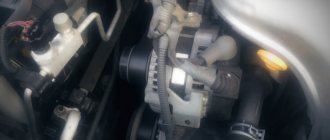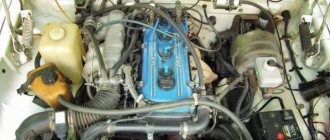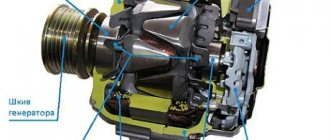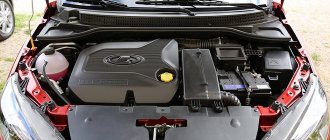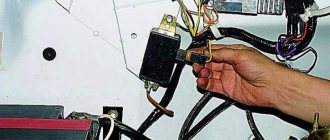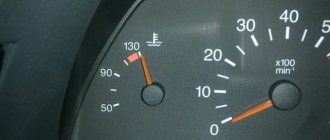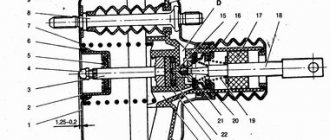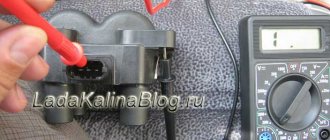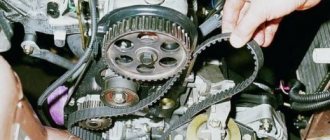What is on the VAZ 2110
For VAZ 2110 cars, the installation of two types of generators is provided, depending on the installed engine.
- For carburetor models, a generator with number 9402.3701 is installed.
- If the engine is injection, then the catalog number of the generator used will be 3202-3771. It has a serpentine belt.
Regardless of the type of installed engine and generator, respectively, problems with the devices are the same, therefore the inspection and repair procedure is identical in both cases.
There is no charging from the generator on the VAZ 2110, what should I do?
If the generator stops charging, there is nothing good about it. It is necessary to immediately begin searching for the cause of such a malfunction. Otherwise, all your electrical equipment will be without power, and the battery will soon run out completely.
If the generator works well, then the battery will not need additional charging with special devices for many months, sometimes even years. The battery will consistently retain at least 60% charge. Thus, the batteries are constantly replenishing their charge reserve through the operation of the generator.
Appearance of the device
Measurements with the engine running
This method is more common as it is quite simple. But it has one drawback - it does not detect problems with the generator. If you are only interested in battery voltage, then it is completely justified.
It is necessary to measure the indicator using the terminals. To do this, multimeter probes are placed on them - the circuit is closed. The device screen should show a reading between 12.5-14 V. This is normal voltage, sufficient for further operation of the car. If the indicator is below this threshold, then undercharging occurs. As a result, problems with starting the car may occur.
This method is the simplest and most effective, because it reflects the current state of the battery. If the voltage level is sufficient, then it returns to its place and connects to the car. Otherwise, it is necessary to determine the cause of this condition.
When the car engine is running, the indicators increase slightly. Typically, the battery voltage ranges between 13.5-14.0 volts. If the charge level is too low, the readings will increase as the generator operates in boost mode.
Although it was stated above what the battery voltage should be when the engine is running, it may be slightly higher for 10-15 minutes after starting. If it does not recover within this time, then there is a problem with the generator or electrical equipment.
After taking measurements, it may turn out that the voltage has not increased, but has dropped slightly. In this case, the battery simply does not have time to charge normally. To check, it is recommended to gradually start up electrical consumers, taking measurements between switching on the devices. The readings will decrease significantly (by 0.2-0.5 volts or more) if the generator is faulty.
Verification method
So, if it seems that the root of all problems with the car is connected with the generator. There is a very simple way to find out if this is actually true. The check must be carried out, as you guessed, under the hood of the VAZ 2109, 21099 and 2110, the generator is located there.
In order to understand whether the generator is working or not, you will need a very ordinary voltmeter. This is done as follows:
- First of all, we start the engine of VAZ 2109, 21099 and 2110.
- Now start the measuring device, switch it to voltage mode and connect the contacts to the battery.
- If at idle the device shows from 13.6 to 14 volts, and at the moment when you turn on all electrical appliances in the car, including the radio, headset, etc., the arrow does not fall below 13.2 volts, then everything is fine. ok. If the value is lower, the generator is probably faulty.
It is almost impossible to check the performance of this device more accurately and quickly. The above method is the most reliable, and experienced auto mechanics advise using it.
When the problem is not in the generator
Since then, when the production of cars using an injector system began, there have been malfunctions that clearly indicate the generator, although in fact this may not be the case at all.
So, first of all, it is worth noting the case when the generator warning lamp stops working. In the case of an injector system, the reasons may be as follows:
- Perhaps the problem is in fuse F19. It is located in the mounting block. It can be treated by simply replacing the same fuse.
- A possible reason is a power failure in some devices, namely:
- There is no voltage from the mounting block to the devices. Check all wires and connections. The problem is most likely with them.
- There is no voltage from the ignition to the mounting block. It can be treated by checking the GP wire at the point of its connection with the ignition switch or mounting block.
- The ignition switch is faulty. You should find a fault in its contact part and fix it.
troubleshooting
Lack of charging can be caused by a wide range of reasons, which we will talk about today.
These reasons include:
- Weak contacts;
- Winding breaks;
- Short circuit on the rotor housing;
- Interturn short circuits;
- Mechanical breakdowns;
- Closing the positive clamp on the body;
- Short circuit in the phase winding;
- Short circuit of the stator to the housing.
Let's look at these situations in more detail to determine the true cause of the breakdown specifically in your case.
Start by turning off all additional equipment in your car that is not included as standard - DVR, navigator, audio system, etc.
Next, we perform the following operations.
- Measure the current output when the vehicle is cold, not running and all life support systems are disconnected. If there is no return at all, that's good. But this rarely happens. Almost always on tens there may be insufficient contact, some kind of short circuit, due to which there is recoil, but it is small. It’s much worse if the recoil is impressive and leads to battery discharge in one night spent in a parking lot or garage.
- If everything is normal, there are no strong current leaks or they are insignificant, and the battery has retained its charge, then you can return all the devices to the places that were installed additionally.
- Recheck the recoil. If at the same time the instruments show an active leak, then the reason does not lie in the battery and is not related to the generator. The culprit of the problem is one of the additionally connected devices.
- If no recoil is observed, then you need to carefully inspect the generator.
- There are many sources of trouble that can lead to generator failure. These include:
- Insufficient contact between the rotor rings and brushes;
- There was a break in the excitation winding;
- An interturn short circuit has occurred on the field winding coil. In this case, the generator will hum and get very hot;
- The field winding closes to the rotor housing;
- The stator shorts to the housing;
- A break occurs in the stator phase winding;
- The diodes have broken through in the rectifier block, that is, the diode bridge;
- The plus is shorted on the body;
- Mechanical problems have occurred.
Next, we will take a closer look at each of the reasons presented above.
Disassembled unit
Problem solving
- Poor contact. Loose contact can occur due to contamination, oil getting on the brushes, slip rings. Also, contact may deteriorate due to shrinkage of the springs that press on the brushes, or the brushes are stuck. Such phenomena lead to an increase in excitation resistance and can sometimes break the circuit. To eliminate the problem, sometimes it is enough to simply treat the surfaces with a rag soaked in gasoline. If the brushes are worn out, it is better to replace them. At the same time, check the condition of the springs and rings. The rings oxidize, so treat them with glass sandpaper.
Disassembled unit
Problem solving
- The winding has broken. If this happens, the battery will no longer charge. To determine the problem, place your hand on the battery. If there is a break, the device will begin to heat up. If you want a more accurate check, then disconnect the end of the field winding from the brush and connect the battery wires to it and terminal Ш using a voltmeter or a light bulb. If there is a break, the lamp will not light up and the voltmeter needle will not budge. Test each coil individually to determine which one is preventing the alternator from working. The internal coils must be replaced, and the internal coils must be soldered.
Unit diagram
- Short circuit between turns. An interturn short circuit can occur in any field winding coil. If such a situation occurs, the winding will begin to heat up, and the excitation current will increase. To check, be sure to measure the resistance of each coil. For this you will need a voltmeter.
- Short circuit on the rotor housing. Such a breakdown leads to the fact that the entire field winding is short-circuited. The generator stops working. The most common short circuit area is where the ends of the winding lead to the rotor rings. To check, use a 220V light bulb. One wire should be connected to any contact of the ring, and the second to the rotor core or shaft. If there is a short circuit, then the light will turn on. It is impossible to operate a car with such a generator. It is necessary to isolate or completely replace the faulty winding. The first option is only suitable for getting to a service station and carrying out a full repair.
- Short circuit on phase winding. This kind of problem occurs because the insulation between the turns of the stator coil is destroyed. If this happens, the generator will start to get very hot, the battery will not receive sufficient charge, as this happens at high crankshaft speeds.
- Short circuit of the stator to the housing. As is the case with the other listed short circuit options, in this situation the generator begins to overheat, hum, and its power drops significantly. To check you will need a 220V light bulb. One wire is connected to the core, and the second to the winding terminal. Any. If there is a short circuit, your light bulb will light up. To fix the problem, simply replace the failed coil.
- The positive terminal closes to the housing. This kind of malfunction is unpleasant because it does not just overheat your generator. Also, due to this short circuit, breakdown of the diodes of the rectifier unit occurs. From there, the problem goes to the battery, which can simply short out. Not infrequently, a short circuit led to complete failure of the battery. Although most often it just completely discharges.
- Mechanical problems. If we take into account all possible mechanical problems of the generator, then belt stretching will be in first place in terms of frequency. This is the most common breakdown in the case of the VAZ 2110. If this happens, the pulley will begin to seriously overheat and the battery will not have enough charge. It is not superfluous to check the quality of all contacts, the presence of broken connections and other possible mechanical problems.
If problems are detected with the generator, you should immediately begin measures aimed at eliminating the breakdown. If you have no experience, contact only trusted service stations.
The alternator is the heart of your vehicle's electrical system. Like the main human organ, it provides power to all instruments and devices. Therefore, you should treat it very carefully and if problems arise, do not delay repairs.
Loading …
Disassembled unit
Problem solving
Unit diagram
Disassembled unit
Problem solving
Unit diagram
To accurately determine the source of the problem with the generator, you need to perform a basic check. If you do not have “additional” energy consumers, you can immediately look for generator faults; if there are any, turn them all off for a while. Moreover, do not turn it off, but simply disconnect it from the car.
- Measure the current output on a cold car, when it is not running and all its life support systems are turned off. It will be ideal if there is no return at all. But this happens extremely rarely. On almost every VAZ 2110, somewhere due to insufficient contact, local short circuit, etc. There is still a small return. But - just a small one, and not one in which the battery can run out during a night of parking;
- If everything is normal, there are no current leaks, or they are negligible, the battery is not discharged, reconnect all those devices that you (no matter, independently or with the help of hired specialists) installed on your car on your own initiative. Repeat the same check. If it turns out that current is actively leaking, it means that the reason is not in the battery and is not related to the generator; it is the device not provided for by the designers of the VAZ 2110 that is to blame;
- But if even then no kickback is detected, we proceed to a thorough examination of the generator. And here there are many possible malfunctions: • there is not enough contact between the brushes and the rotor rings; • there is a break in the excitation winding; • an interturn short circuit is possible directly in the field winding coil. At the same time, the generator heats up and hums; • the field winding may short-circuit to the rotor housing; • breaks can also occur in the stator phase winding; • the stator can short-circuit to the housing; • possible short circuit of the “plus” to the housing; • diodes in the rectifier unit can be pierced; • mechanical failures also occupy a significant place on this list.
Reasons for low charge output
There are two reasons why the VAZ-2110 generator produces a low charge:
- Mismatch between the battery and the car's generator.
- Overload.
For the first reason, the generator may produce little charge due to the fact that owners of VAZ-2110 cars install additional electrical equipment. To do this, they also purchase and install a much more powerful battery. In this case, the generator does not have enough resource.
The second reason suggests that motorists overload the VAZ-2110 generator with various video devices, various speakers, electric pumps, etc. Additional devices greatly reduce the charge.
It is worth paying attention to how much it is necessary to supply to the VAZ generator for normal operation of the entire mechanism. This norm always depends on the technical condition of the car itself as a whole:
- if the car has driven a long enough distance, the generator can produce a voltage of 14.0-14.2 V;
- if the car is parked and has a cold engine, the charge will be 14.2-14.4 V.
Also, a lot of reasons can be attributed to the low charge of the VAZ-2110 generator. These can include such as wire breaks in the winding, weak contacts, and stator short circuit. The closure of the rotor housing and the interturns also affect the small charge. Mechanical problems with the generator affect the decline in performance.
In order to finally make sure that the VAZ-2110 generator cannot produce the required charge, it is necessary to find the final reason. First of all, you must disable all installed additional equipment that is not included in the complete vehicle package. This includes a navigator, audio speakers, video recorder, etc. Next, it is important to measure the return current output when the engine is cold, remembering to turn off the entire life support system of the car. It's good if there is no return. If this occurs, the battery will discharge very quickly. After performing a repeated drive, you will finally be convinced that there are no problems in the battery, and it is not the reason for the VAZ-2110 generator to issue a low charge. All removed devices can be reinstalled.
The next step in checking that the generator is not capable of delivering a charge is to check the power delivery mechanism itself. The reason may be quite serious. This is both insufficient contact of the brushes with the rings and a break in the wires in the winding. The generator can heat up and hum due to the short circuit of the excitation coil, or a phase failure of the stator winding. It is also capable of delivering a bad charge (small) due to mechanical deviations.
Basic problems
A lot depends on the operation of the VAZ 2110 generator. If it malfunctions, what can start the battery? And when it stops providing the required voltage, you have to urgently figure out what the reason is. But just by external signs you can determine that the generator is creating problems:
- The charging light starts flashing at low speeds;
- there may be a burning smell in the cabin;
- there are mechanical damages.
If a visual inspection does not bring results, you must:
- remove the plastic cover from the generator;
- check all electrical connections;
- Unscrew the diode bridge, as well as the voltage regulator relay with brushes.
Diodes are checked with a special tester. When they operate normally, the current will only flow in one direction. If the current flows in two directions or the diodes do not pass it at all, then the reason has been found.
If the generator begins to act up, then the main causes of the malfunction should be sought either in the on-board network, or these are problems with the generator itself. If the generator gives a charge, but not enough, then perhaps it has been “loaded” too much by installing many other gadgets in addition to the standard electrical equipment, and it is already working at the limit of its capabilities.
Our motorists really love tuning the VAZ 2110, adding, for example, speaker power, enhancing the light, etc. In such cases, some people change the battery, for example, installing it with a capacity of 70 Ah, instead of the usual VAZ one with 55 Ah.
But although this may help at first, over time such a battery will run out even faster, since a standard generator will not be able to provide it with a full charge; it does not have enough power for this.
Solving the reasons that have arisen
Experts advise immediately solving problems with the causes of low charge output from the VAZ-2110 generator.
If a weak contact occurs, it is necessary to clean it from dirt and oil. This can be done with an old clean rag with gasoline. If there is visible wear on the brushes, they will need to be replaced. Do not forget about the condition of the rings and springs. It is also important to clean them.
Broken contacts can be eliminated by replacing the coils, which can be easily checked using a voltmeter or a light bulb. Coils require replacement if a short circuit occurs between the turns. A breakdown in the form of a short circuit on the rotor housing can completely stop the operation of the VAZ-2110 generator. The breakdown is checked using a lamp (220 V). If there is even the slightest short circuit in the network, it will light up. In this case, it is important to replace the winding.
Mechanical damage very often includes belt stretching. Today, this is the most common reason for the breakdown of the generator, which can produce little charge.
It is worth noting that if you discover at least one of the reasons for the poor operation of the generator, you should immediately correct it. If you do not have experience in this, you need to contact a service station.
As you know, the generator is called the main organ of the car. It affects the entire operation of the power system of devices and equipment of the machine. If a breakdown occurs, it is important to immediately find and eliminate the cause.
The generator in a car converts mechanical energy into electrical energy. After starting the car, the generator starts working and charges the battery, as well as all electrical equipment installed on the car.
The generator is located under the hood and is driven by the crankshaft. Sometimes it may happen that the generator on the VAZ 2110 does not charge. This can lead to a blackout of the car and after some time of movement of the car, it will no longer be able to move.
Where is the VAZ 2110 generator located?
If the generator is working properly, then you should not periodically recharge the battery with external chargers. It must work properly for a long time, charging only from the generator. The battery should always have 50-60% reserve charge.
For the VAZ 2110 car, two types of generators can be used. If the car is carburetor, then the generator number will be 9402-3701. If the car is fuel injected, then the generator number is 3202-3771. Although they are not particularly different from each other, the nature of their malfunctions is the same.
For example, on a VAZ 2110, the 8-valve injector does not charge the generator, for only a few reasons:
The vehicle has an excessive amount of equipment that supplies more electricity. These could be additional speakers, audio/video devices and various pumps and vacuum cleaners. A conventional generator cannot cope with such a load and therefore stops properly supplying charge to the battery.
generator and battery do not match. If the car has a lot of additional devices installed that require electricity, then the owner installs a more powerful battery. Explaining this by the fact that a more powerful battery will be enough to operate all third-party equipment. But in fact, the VAZ 2110 generator will produce little charge, the reason is that it will not be enough for a strong battery.
When the generator of a VAZ 2110 car does not charge, there may be other reasons. The generator may be damaged mechanically. Contacts oxidize over time. Somewhere they may simply come off; poor fastening of the wires can also lead to a malfunction of the generator. You need to pay special attention to the rotor. Since on the rotor body, a short circuit may occur.
Causes of breakdown of the VAZ 2110 generator
In order to identify the cause of a generator malfunction, it is necessary to consider all possible options for its failure separately.
- First, one by one, you need to turn off all digital devices. Radio, DVR, navigator, speakers.
- After everything is turned off, the car is not started and warmed up, it is necessary to measure the current output. The mark should be at zero. The higher the mark, the faster the car battery will drain. Even overnight it can discharge to zero. If the indicator is good, you can reconnect everything, and then check the current output again.
- The problem may lie in the connected devices themselves. If the indicators are normal, then you need to carry out a full diagnosis of the generator itself.
- The cause of a generator malfunction may be a short circuit in the stator, damage to the field winding, breaks, or a loss of connection between the working elements in the generator. But there is always a solution, you just need to know what to do.
- If it's still a bad connection. The connection may be broken due to oil getting on the brushes or rings. Also if the brushes hang, if the springs have settled. Sometimes this problem can be solved simply by wiping everything with gasoline. And sometimes it is impossible to do without replacing spare parts that have already worn out. If the rings are oxidized, they must be cleaned with sandpaper.
- The generator may not work due to a winding break. Then the battery does not receive any charging at all. Checking this is as easy as shelling pears, put your hand on the battery, if it gets warm under your hand, it means there is a break.
- Interturn closure. At any time, the winding may start to heat up and the coils will fly, so you need to check all the coils individually using a voltmeter.
- Short circuit on the rotor housing. Due to the short circuit, a general short circuit of the entire winding occurs and the entire unit stops working. To check the malfunction, just take a light bulb and wires. Connect them to any contact and to the rotor. If the light comes on, it means there is a short circuit. Afterwards it is necessary to completely replace the entire winding.
- Short circuit in winding phase. If a short circuit occurs, the generator will become very hot and the battery will remain without charging.
- Stator bridging. The generator will also heat up. A hum and various sounds appear. Again, you can check it using a light bulb and wires. The solution to the problem is the usual - replacing the coil.
- Mechanical failure of the generator. If the pulley on the generator overheats, the charge drops and the battery receives little charge. First of all, you need to diagnose all contacts and look for the broken one.
The main reasons why the generator does not charge the battery
Fault No. 1
Checking the voltage in the on-board network
- Tension of the VAZ generator drive belt - tighten if necessary;
- If the rectifier block valve is damaged, replace the entire rectifier block;
- Diodes powering the exciting winding of the rotor - replacement of diodes or the entire rectifier block;
- The outputs of the exciting winding coming from the slip rings for their unsoldering - solder the outputs/replace the rotor or the entire generator assembly.
It is also possible that the stator winding may short-circuit, break or short circuit to ground (in this case, noise from the generator appears in the VAZ 2110, the generator “howls”). These assumptions are checked using an ohmmeter; if a malfunction is detected, the stator or the entire generator must be replaced.
Malfunction No. 2
The warning lamp in the instrument panel also indicates that the battery is low, and the tester displays a voltage value in the vehicle circuit of at least 14.7 volts:
- The voltage regulator has definitely failed (the contacts of the “DF” output have closed with ground) - replace the regulator.
Malfunction No. 3
The generator noise is clearly audible in the VAZ 2110:
- If sounds such as howling and squealing are heard. When disconnected, the wires remain, and when the drive belt is removed, they disappear, this means that the bearings have failed - replace the bearings (the front one is replaced as an assembly with a cover);
- If, when the wires are disconnected, the noise disappears, this indicates a short circuit in the stator windings and their connection to ground—replace the stator/generator.
Also in this case, one of the valves may close, which threatens to replace the rectifier unit.
Malfunction No. 4
The warning lights in the instrument panel do not light up when turning the ignition key:
- Checking the “F19” fuse in the mounting block - replacement (it is advisable to find out the reason for the fuse failure);
- Open circuit in the instrument cluster “ignition switch” - check the integrity of the blue wire with a red stripe running from the mounting block to the ignition switch, as well as the orange wire running from the instrument panel to the mounting block;
- Malfunction of the ignition switch contact group - check the presence of a contact with a tester, if necessary, replace the contact group or the entire ignition switch.
Malfunction No. 5
When the ignition is turned on and the engine is running, the warning lamp indicating a low battery does not light up, the remaining lamps in the instrument cluster work:
- Burnt-out control lamp/poor contact – replace the burnt-out lamp/clean and press the contacts in the seat;
- Open circuit “generator output “D” to the instrument panel” - check for continuity of the brown wire with a white stripe coming from terminal “D” to the instrument panel;
- Oxidation of contact rings, as well as hanging and wear of brushes - the brush holder assembly with brushes should be replaced, the contact rings should be wiped with a clean cloth moistened with a degreaser;
- Open circuit “DF terminal – ground” (damage to voltage regulator) – replace the regulator;
- Broken brush holder wire from terminal “D” - restore contact;
- The positive diodes (valves) have closed - replace the rectifier unit;
- The leads coming from the slip rings to the rotor excitation winding have been unsoldered - solder the leads in place/replace the rotor/replace the generator.
This is where the list of the main malfunctions of the VAZ 2110 generator ends, I hope that this instruction will help you out at the right moment. As they say - no nail, no wand)))
It is traditionally believed that 13.5-14.5V should be supplied by the generator to the battery and this is absolutely enough to replenish the battery costs.
It is worth considering that using a battery with a higher power in a car than the manufacturer recommends also requires the installation of a more productive generating device.
It is necessary to take into account the load that the generator must withstand - it is calculated based on the maximum indicators of all electrical appliances and car systems.
Do not forget that the charging current from the energy-generating device will allow you to start the car in the cold season. In order to avoid problems with starting the car, we recommend purchasing generating equipment, the charge current of which will be approximately 10% of the capacity of the power source.
That is, a battery of 100 A/h requires a generator that can produce 10A. Please note that for many cars, 100 amp equipment will operate at its maximum capacity, because the power consumption of the automotive system is in the region of 80 amps. Therefore, the choice of a source generating energy must take into account both the battery capacity and network consumption.
The current strength required by the electrical system of each car is individual and depends on the number of electricity consumers and their values. And also the charge current must be sufficient to charge the power source.
It is worth noting that ampere readings appear only when there is a load in the vehicle’s electrical system and, accordingly, the battery is discharged. After starting the car engine, the charging current is about 6-10 amperes and drops over time, because the battery is charging, taking on the main energy consumption. If you turn on additional equipment - headlights, radio or heated mirrors, you can see an increase in the charging current values.
When purchasing a generator, pay attention to its technical characteristics, which the manufacturer indicates on the case - that’s where you will find information about the maximum current that will flow to the battery.
In the table below you can see the approximate current values that the generator shows at different loads.
Table 1. How many amperes the generator produces under load.
| Symptoms | Possible breakdowns | Remedy |
| At idle, the headlights flash in time with the engine. | Weakening of the belt tension, wear of the brushes, breakdown of the diode bridge. | Determine the cause, replace the failed part, tighten the belt. |
| The battery has failed to charge (the battery does not charge). | Failure of brushes or voltage regulator. | Replace the “tablet” (RRN) or “horseshoe” (diode bridge). |
| Noise, hum when working under load | Bearing wear | Replace bearings or assembly |
| As the revs increase, charging disappears | Damage to the diode bridge | Replace the diode bridge or resolder and repress the diode. |
| After starting the internal combustion engine, especially during rain, a whistle is heard. | Drive belt slippage | Adjust the tension or change the belt. A temporary solution is to treat the stream with anti-creak spray or rosin. |
Practice shows that if repairs cannot be accomplished by replacing the brush assembly with a built-in voltage regulator, then it is advisable to send the device to a specialized service center or replace the complete unit.
A small potential difference in the system is not always associated with a breakdown of the generator or a bad battery. If the diagnosis of these elements does not reveal any problems, then you should pay attention to the following:
- condition of the battery terminals - connection density and oxidation;
- electrical wiring problems - oxidation, violation of its integrity;
- output contacts to electrical appliances;
- correctly selected energy consumers.
Each contact must be tightly adjacent and intact, that is, there must be no formations (for example, sulfation) that will disrupt the flow of current. Incorrect connection of contacts leads to accelerated battery discharge even when the car is not running.
To improve the connection of the elements of the car's electrical system, it is necessary to clean all contacts and restore the integrity of the wires by replacing them or connecting them and wrapping them with insulating tape.
In conclusion, I would like to repeat that stable operation of the car requires constant monitoring of all elements, and the generator should attract special attention. The battery is charged from it and provides electricity to the entire car system. Pay attention to all elements: generator brushes, slip rings, voltage regulator, equipment winding.
The most correct measurements should be carried out when the battery is fully charged and in various modes. Remember that the manufacturer links the characteristics of the generator to the number of engine revolutions - they help produce a certain current.
Do you have experience diagnosing an alternator and solving problems in a vehicle's electrical system? Please share your experience and opinion with our readers in the comments. If you have questions about the topics covered, we will be happy to answer them.
The standard equipment of the VAZ-2110 car includes a battery with a capacity of 55 Ah. It holds a charge quite well and may not require refilling for many months. The thing is that all voltage losses are compensated by the operation of the generator.
To identify problems, it is necessary to diagnose both the entire on-board network, which may draw too much energy, and the generator itself. If you have tuned your car, equipping it with additional electrical equipment, you will need to check its energy consumption level and serviceability.
The generator produces insufficient voltage. What to do?
Insufficient charge level of the car battery causes the engine to fail to start. At night, insufficient voltage at the generator output can cause the engine to stop while driving. If the battery charging indicator light on the dashboard begins to blink or stays on while the engine is running, you should immediately measure the generator voltage supplied to charge the battery. You should also measure the voltage on the battery with the engine running.
Causes of low voltage, methods of control and repair
The voltage supplied to the battery during operation of the power unit should be in the range from 13.2 to 15.0 Volts. If it is more than 15 Volts, the battery may be overcharged and the vehicle's electronic devices and additional devices may fail. If the voltage is less than 13 Volts, the battery is charged ineffectively; when powerful power consumers of the car are turned on, an extreme drop in the on-board network is possible. If less than 12 volts, the battery does not charge at all.
1. Weak belt tension.
Often this reason is accompanied by a belt drive whistling. It is also possible that lubricants and other liquids may come into contact with belt drive areas (pulleys, rollers). The belt should be cleaned using non-aggressive solvents. The belt also needs to be tightened. The level of “sagging” of the belt on a long free section when pressing on it with your thumb should be in the range from 0.5 to 1.0 centimeters. Over-tensioning is also dangerous: it leads to premature failure of rollers, bearings and bushings.
2. Failure of the “tablet” (chocolate) of the generator
. This is sometimes called a voltage regulator relay. Usually it cannot be repaired; it should be replaced with a similar one. In many cases, the regulator can be replaced without dismantling the generator.
3. Wear of generator brushes.
Sometimes they are included in the relay-regulator system and are replaced together with it. The remaining length of the brushes must be at least 7 millimeters; if less, they must be replaced.
4. Breakdown of rectifier diodes
. This malfunction occurs when the battery polarity is reversed. The generator becomes very hot when the engine is running. The diode “horseshoe” is changed completely or the diodes are replaced element by element.
5. Broken generator windings.
Inoperability can be determined by the different colors of the varnish insulation of the windings. In this case, the stator or rotor assembly is replaced. Rewinding windings is unprofitable.
If you liked the article, like and subscribe to the channel.
Every day we publish new interesting articles .
What malfunctions can occur in the generator?
What could be the problem with the generator when, when you turn on the ignition, the light flashes or does not turn on at all and the control devices do not function? You should check to see if the fuse located in the mounting block is ok. If there is a break in the power supply, the following may occur:
- the “O” wire with the wires from the mounting block to the devices is broken;
- there was a breakdown of the “GP” wire with the wires from the ignition switch to this unit.
If the battery is discharged, the generator voltage will not give the desired figure.
And the reason may lie in the fact that the control lamp has burned out, or perhaps the socket contacts are not pressed sufficiently against the printed circuit board. In this case, the lamp or faulty contacts are replaced.
You should look to see if there is an open circuit in the circuit connecting plug “D” of the generator and the devices. If this is exactly the case, then you need to look at the “KB” connections.
A lot also depends on the brushes if the VAZ 2110 generator does not produce the required power. They can wear out, freeze, the contact rings can oxidize, then you need to replace the entire brush holder along with the brushes. Oxidized parts are wiped with gasoline.
The terminals of the generator winding may become unsoldered from the slip rings, which need to be soldered or the surface of the generator rotor should be leveled.
A short circuit may occur in the valves, and the rectifier will have to be replaced. If the generator is noisy, it means there is a breakdown - the bearings are damaged; If the generator makes too much noise, you need to check the stator.
But when the generator 2110 does not produce 14.2 V, as it should, you need to start the engine - let it run for a while. In a few minutes, pressing the gas pedal, you need to increase the crankshaft speed to 3000 rpm. Now all functions should work, after which the voltage at the battery terminal is measured.
The voltage at this moment should be greater than 13 V. Other numbers indicate that there is a breakdown in the winding, or a short circuit may have occurred. You also need to check the voltage regulator with brushes; Maybe the reason lies in the oxidation of the generator winding rings.
The voltage regulator is checked by turning off all functions, but leaving the high beams on. Now you need to measure the voltage again, observing what it is now. Your mood will improve if the device shows the numbers 13.2-14.7 V.
The generator may be undercharged if the pulley is just spinning, and under heavy loads it begins to spin.
The normal output at idle is 14.2 V. Use a multimeter to take a measurement, but before that you need to check the input and output. Experienced craftsmen advise taking a welding cable, attaching the minus to the motor, and bringing the plus to the generator. If the result is negative, the generator needs to be changed.
Constant undercharging of the battery or its absolute discharge at the most inopportune moment is a headache for many car owners. One source of these problems may be the generator. But how to check it? Perhaps it's not his fault at all? Let's figure out together how much the generator must produce for the normal functioning of all car systems and maintaining the battery in a charged state.
Maintenance and testing of the VAZ generator
| The VAZ generator is a fairly reliable device that can withstand engine vibrations, high temperatures under the hood, and exposure to the external environment (dirt, humidity, etc.). Despite this, it happens that at the most inopportune moment the generator lamp lights up on the instrument panel, and the battery begins to rapidly discharge. Do you know how to maintain and, if necessary, check the generator in the field? |
Chassis front and rear suspension VAZ 2110 2111 2112 Removing the lever and extension of the front suspension VAZ 2110 2111 2112
Generator maintenance Generator maintenance consists of:
in cleaning external surfaces. in checking the fastenings of the generator to the engine. in checking the reliability of the connections of the wires with the generator and voltage regulator; in checking the tension of the generator drive belt (if the tension is weak, the generator will operate unstably; if it is strong, the belt and bearings will wear out quickly). The check should be carried out every 10 thousand km. mileage in checking the condition of the generator belt (there should be no cracks or delaminations on it). in checking the condition of the generator bearings (remove the belt and rotate the generator rotor by hand; if jamming, play, noise or clicks are observed, the bearings should be replaced).
As you may have noticed, independent maintenance of the generator is kept to a minimum and does not require any special knowledge or skills. This work can be limited to until any malfunctions appear.
Checking and tensioning the VAZ 2110 generator belt If we talk about the VAZ of the tenth family, then the generator belt according to the norm should bend by 10–15 mm with a force of 100 N (10 kgf).
It is recommended to check the tension with a special indicator, but if it is absent, you can check the belt tension with a household steelyard. If the belt needs to be tightened or loosened, then loosen the nut shown in the figure, and move the generator away from/towards the engine, and tighten the nut again.
Checking the generator using the warning lamp It is recommended to check the functionality of the generator when starting the engine using the dashboard warning lamp (no. 16). After turning on the ignition and before starting the engine, the lamp lights up, which allows you to check its functionality. After starting, the control lamp goes out, which indicates normal operation of the generator.
If the lamp lights up brightly or glows at full intensity while the engine is running, this indicates a weak tension (break) in the generator drive belt or a malfunction in the charge circuit, and possibly the generator itself.
For a normally operating generator set, at medium speeds, the voltage should be within 13.5...14.2V. The magnitude of this voltage is measured with a voltmeter at the battery terminals. Embed this video on your site
Generator diagnostics A burning battery charging indicator lamp does not always indicate a malfunction inside the generator. Most often, the malfunction is trivial and lies on the surface. Before removing the generator, it is recommended to use the generator preliminary diagnostic circuit (you may need a voltmeter with a scale of at least 15V).
If preliminary diagnostics have shown that the excitation winding circuit is working properly, and the fault is in the generator, then after removing it, it is advisable to check all the circuits, including the relay regulator.
By the way, after installing 'strong' acoustics, a subwoofer and other sources of consumption, the standard generator may not be able to cope. In this case, you can replace it with a more powerful one, or modify the generator.
How to check the operation of the generator
The battery in a car is an important element of the system, which is responsible for providing the car’s on-board network with electricity. The generator is used to charge the battery while it is active. Unstable operation of a device generating electricity causes a voltage drop in the network and failure to restore the capacity of the power source.
Normal generator performance means timely and complete replenishment of the battery charge level, which decreases under load. Checking the battery charge level from the generator is simple and can be done by the car owner himself.
Diagnostics of an automotive energy-generating device includes a visual inspection of the unit, its elements and related parts, as well as voltage and current measurements. At least twice a year, you should check the tension of the drive belt, excessive weakening of which leads to a decrease in the performance of the generator, and sometimes can lead to breakdown of the device.
Diagnostics of indicators such as voltage, current, resistance are also necessary twice a year. To carry it out, you will need special devices - a voltmeter, multimeter or load fork.
About recharging
The power source must be recharged at the right time, then the voltage will be optimal during operation. However, when conducting such an event, certain requirements must be met.
- Charging must be carried out at positive air temperatures.
- The filler plugs should be unscrewed and left directly in the holes before connecting to the network.
- The device used must have a voltage of 16 volts.
- Do not tighten the plugs for 20 minutes after switching off. Accumulated gases must completely leave the interior space.
- The device is charged in a room with supply and exhaust ventilation.
Try our service station selection service
Creating an application is absolutely free and will take you no more than 5 minutes
A lot of motorists are interested in the power of a car generator. After all, there are now a lot of electrical devices (for example, inverters) that can turn your car into practically a power plant for a country house. Many carry loads of 1000 – 1500 and even 2000 W! Is it a lot or a little?
Can a running car do this? Some write that – NO! Others that - YES! But often they have a “mess” in their heads; I often see such statements on forums: the power is no more than 300 - 600 W. Where these numbers come from can be seen from the ceiling. Let's correctly define power, and also find out what it depends on...
THE CONTENT OF THE ARTICLE
In this article I will introduce you to the approximate power of your car alternator, this is physics grade 7. Let's take into account that we have direct, not alternating current.
Basic measuring instruments
Before talking about what the battery voltage should be, you need to familiarize yourself with the basic devices designed to take readings. With their help, you can make the most accurate measurements in normal condition and under load.
- A multimeter is a universal device for working with various electrical circuits. Devices can be analog or digital. However, as a rule, the latter of them are used. In this case, the readings are displayed on a special display, which is small in size.
- Load fork. The simple version contains a voltmeter with the ability to measure resistance. The body is usually made of metal. It is located on a special handle. More complex devices may contain additional elements.
It is not recommended to use the load fork too often, as regular measurements may deteriorate the condition of the battery. In the case of a multimeter, there are no restrictions.
Dismantling and repair
After you have succeeded in removing the device, you need to perform an inspection and find defective parts. It is better to carry out diagnostics at a service station in order to be sure which part needs to be removed and a new one installed. The work must be carried out in a garage with an inspection hole. Disassembly is performed as follows:
- The negative terminal must be disconnected from the battery;
- The next step is to remove the power plant mudguard. After this, access to the generator excitation wires will appear - they must be removed;
After performing troubleshooting, you can understand whether the VAZ 2110 generator needs to be replaced or not. In some cases, it will be enough to replace a few worn parts. When disassembling, you should have a diagram at hand. If you have no experience working with electrical appliances, it is better to contact a service center.
Signs of a generator malfunction
In modern cars, breakdowns of the electrical system are one of the most common. A large number of electronics requires particularly careful monitoring of the operation and condition of the generator and battery, because their failure can immobilize the car. The most common signs of a generator malfunction are:
- battery indicator light on the instrument panel;
- unstable operation of the battery (its boiling over or undercharging);
- different intensity of headlights;
- extraneous sounds from the generator.
If you notice incorrect operation of the car, then perhaps the battery charging current from the generator is insufficient.
All malfunctions of electrical equipment, which includes the vehicle’s energy-generating device, are mechanical (deformation or breakage of fasteners, housing, malfunction of bearings, pressure springs, drive belt, etc.) or electrical (winding breaks, diode bridge malfunctions, burnout or wear of brushes , short circuits between turns, breakdowns, etc.).
Don’t write off a non-working generator: find out if there are repair kits and spare parts. Replace them if possible. If you cannot carry out repair work yourself, then take the generator to a workshop. Many craftsmen will be able to restore the unit at no extra cost and in the shortest possible time.
However, some breakdowns require the purchase of a new device that generates electricity. For example, a failing bearing that is soldered into the generator housing cannot be restored or replaced in most cases.
Remember that failure of this unit can be caused not only by wear and corrosion, but also by poor quality of elements and components; excessive load; external influence of salts, liquids, temperatures.
Design features
So, before dealing with malfunctions, there is a principle of operation of the device. We take VAZ 2110, 21099 and 2109 as a basis. First of all, you should understand that this device actually works only due to electromagnetic induction. However, we will not delve into the basics of elementary physics, but rather let’s figure out what the device consists of that generates alternating current for the electronics of VAZ 2109, 21099 and 2110 cars. In the case of these cars, a classic type of generator is used, which has the following design:
- Rotary part of the device.
- Stator.
- Device body.
- Voltage regulator.
- Generator brush assembly.
- Rectifier block.
In general, if we talk about the generator as a whole - this device has exceptional reliability and breaks down very rarely, the main reason for the malfunction of the device that generates current for VAZ 2109, 210999 and 2110 cars can be the following factors:
- The parts for the generator are either counterfeit or defective.
- Exceeding operating standards (very rare due to the fact that those same standards are very high and difficult to achieve).
- Corrosion as a result of foreign liquids entering the mechanism, for example, salt water, road reagents or dirt.
In addition to these very basic faults, which are associated with mechanical or electrical breakdowns in the electrical system of the VAZ 21099, 2109, 2110. The case can be either typical or completely original. However, before undertaking repairs or diagnostics, it makes sense to study the qualifying signs of a generator malfunction.
Generator VAZ 2110


